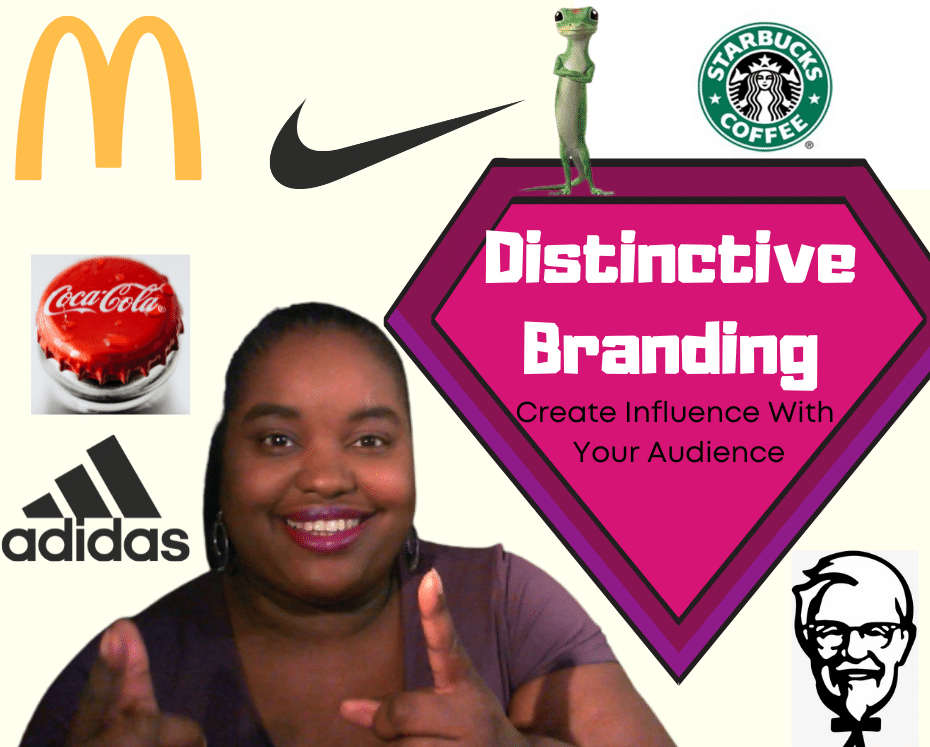I would like to start by saying that this post is what I would call an upgrade or super-sized topic. It is not your usual topic when it comes to developing a personal brand for Home-Based Business Solopreneurs. And to be perfectly honest, most Solopreneurs who are building a business from home are not diving this deeply into the nuances of Distinctiveness. This is a shame really because it is just as important for you to have a clear understanding of what it means to be Distinctive – especially since you are the face, heart, and soul of your business. And if you desire to create a 6, 7, or even 8-figure Home-Based Business then Solopreneurs let's Super-Size your personal brand with Distinctive Branding.
As a whole, for a Solopreneurs to create Distinctive Branding and to create influence and assets is putting a Trademark on you as the Brand. Just like a Trademark, you as the brand can not be similar to any other brand.
I've done extensive research on some of the top personal brands that have clearly propelled in the area of Distinctiveness within their brands. People like GaryVee, Lisa Price, Neil Patel, Jenna Kutcher, Leon Howard, Diane Hochman, & Ray Higdon to name a few. If you are serious about going the extra mile in creating a powerful, distinctive, personal brand that will attract your ideal clients and propel you to the top of your industry…then this post is for you.
What Is Distinctive Branding?
The definition of a Distinctive Branding is “a brand that is significantly different from its competitors in terms of one or more key brand dimensions.” In order to create a distinctive brand, you must understand what the key dimensions are for your industry and make sure that your brand is differentiated on at least 2 or more of them.
For example, if we look at the key dimensions for a personal brand in the online coaching industry, they might be:
-Credibility
-Relatability
-Expertise
-Engagement
-Authenticity
And if we look at 2 well-known personal brands in this industry, we can see how they differ on these dimensions. Neil Patel is known for his credibility, SEO expertise, and YouTube engagement, while Jenna Kutcher is known for her relatability, her Gold Digger Podcast, and authenticity.
Let talk more about Key Brand Dimensions and how to identify them?
A key brand dimension is an area where you can position your brand to be different from your competitors. I often like to think of it terms of your personal brand being a Trademark. Trademarks by definition are designed to not be like anything else. There are two types of key brand dimensions – functional and emotional.
Functional dimensions are the more rational, logical aspects of a product or service. They are the features and benefits that solve a problem for your target market. Emotional dimensions are the intangible, experiential aspects of a product or service. They are the values, beliefs, and personality of your brand that connect with your target market on a deeper level.
Some examples of Functional dimensions might be:
-Quality
-Price
-Convenience
-Selection
And some examples of Emotional dimensions might be:
-Prestige
-Status
-Identity
-Community
When it comes to personal branding, I believe that the emotional dimensions are more important than the functional dimensions. This is because people do not buy products or services, they buy experiences. And the best way to create an experience for your target market is to connect with them on an emotional level.
Now that we understand what Distinctive Branding is and some of the key dimensions that you can use to differentiate your brand, let's dive into why is brand distinctiveness is important for Solopreneurs.
Is Brand Distinctiveness Important for Solopreneurs?
Let's continue with the concept of you as a trademark. There are many reasons why a trademark should be distinctive. For example, trademarks with the most distinctive design gets registered first. The higher up on the distinctiveness spectrum your registered logo, graphics, or design goes, meaning less similar to other trademarks, is what protects your brand from infringement more effectively under US Law.
In that same manner, as a Solopreneur, you are your brand, you are the trademark. You have to create distinctive features that are only yours. Again less similar to other personal brands (ie... other trademarks). This means that you need to be Deliberate about how you present yourself to the world. There are 3 main ways to create Deliberate Brand Distinctiveness:
- Clear Aligned Narrative Focused Around Service To Your Target Audience
When someone looks at the body of your work, there should be a clear narrative that aligns you to a specific group of people. There shouldn't be generic, general, or broad, anywhere around what your brand is and who it's for. Your narrative should be targeted, narrow, clear, and focused.
- You Need A Website As A Hub To Tell Your Story & Distinctive Branding
First as a brand you should have a Personal Branded Website. When someone visits your website there should be a clear story about who you are, what you stand for, who you are going to help, what types of people you work with, what product or services you offer, and where are you now as a business and where you are wanting to go in the future.
- Start Positioning Yourself As The Leader of One Target Audience, & Building On One Targeted Topic
Being a leader in short means you are the go to person. Positioning yourself is done through the process of growing from smaller steps to larger steps. So you have to start with one target audience, and master one targeted topic.
Next, let's look at how you can create influence & assets with your distinctive brand.
Distinctive Brand Assets & Using Them To Influence
Let's start with the definition of Distinctive Brand Assets? I like to think of Distinctive Brand Assets as the unforgettable elements or building blocks of a brand. They come in many forms, such as logos and fonts but can also be more abstract like sound or music that tells people about your business without having to say anything at all!
The way you use these things will really set you apart from competitors because nobody else has thought of using this technique before, making theirs seem old-fashioned by comparison.
A great example of this would be in Brands Like Nike, Coca-Cola, or McDonald's. If I said "badabababa I'm loving it" or "Just Do it" or even if I started singing "I like to give the world a _________" I bet you could fill in the blank. These iconic brands have created brand assets that when you just hear a song, or see a swoosh symbol you know exactly who they are without question.

You might be thinking, but these brands have been around for years and are huge. They are not some small Home Based Solopreneurs like my business. If I showed you these pictures you may or may not recognize these people, but all of them started businesses from home and that are now worth millions. They all tapped into what made them distinctive.
The most important thing I can say is that all of them have clearly crafted intentional brands. Here are a few Distinctive Brand Assets Examples:

Gary Vaynerchuk

Jenna Kutcher

Diane Hochman

Ray Higdon

Tony Robbins

Tai Lopez

Lisa Price

Martha Stewart

Leon Howard Wallstreet Trapper

Neil Patel
Gary Vaynerchuk- Distinctive Brand Asset: No Filter Persona
Jenna Kutcher- Distinctive Brand Asset: Girl Next Door Aesthetic
Diana Hochman- Distinctive Brand Asset: Motherly Personal Transformation
Ray Higdon- Distinctive Brand Asset: Networker Go-Giver Mentality
Tony Robbins- Distinctive Brand Asset: Vibrant Energetic Personality
Tai Lopez- Distinctive Brand Asset: Living The Life - 67 Steps Program
Lisa Price- Distinctive Brand Asset: Funky Urban Organic Natural Aesthetic
Martha Stewart- Distinctive Brand Asset: Lifestyle Expertise
Leon Howard- Distinctive Brand Asset: From The Street Attitude Business Educator
Neil Patel- Distinctive Brand Asset: Data-Driven SEO Marketing
What is interesting about all of these examples is that they each have a very different approach to their business. However, they all use their distinctive brand assets to create an emotional connection with their audience.
For example, if you watch any of Tony Robbin's content, he is high energy, always moving around, and speaking very fast. This creates an emotional connection with his audience by giving them this high level of energy that they may not be able to access on their own.
Martha Stewart is known for her perfectionism and attention to detail. She creates an emotional connection with her audience by being the expert in everything lifestyle related. She pulls her audience in by slowing down the pace and makes you pay attention to the details.
On the other hand, Leon Howard The Wall Street Trapper pulls his audience in by being relatable. He talks about coming from the street and making it big. This creates an emotional connection with people who are looking for someone who has been through similar experiences.
The bottom line here is that when you create a deliberate brand, you will be able to use your assets to establish influence with your audience that will help you stand out. You need to be very intentional about the way you want to show up in the world and make sure that everything you do lines up with that message.
Now that you know what Distinctive Branding is, the importance of it for Solopreneurs, and how to start using it to create Influence & Assets. I want to give you some action steps as a Home-Based Business Solopreneur you can use to create assets and influence in your industry.
Action Steps Creating Assets and Influence For Solopreneurs
Action Step 1:
The first thing you need to do is to create a list of what makes you distinctive (think trademark)? What are the things that make you unique? This could be anything from your personal story, your experiences, your skillset, your beliefs, or even your physical appearance.
Action Step 2:
Once you have a list of what makes you distinctive, you need to start sharing that with the world. This could be through your social media, your blog, or even in person. Remember, you want to be very intentional about the way you are sharing your story and make sure that it is aligned with the message you want to send to the world.
Action Step 3:
The last thing you need to do is to start using your assets to create influence in your industry. This could be through speaking engagements, writing articles, or even just networking with other people in your industry. Remember, the goal is to use your assets to establish yourself as an expert in your field and to create a connection with your audience.
KEY TAKEAWAYS
- Home-Based Business Solopreneurs should spend more time in developing a Distinctiveness in their Brands.
- Distinctiveness Branding is important for Solopreneurs because it helps them to stand out from the competition, establish themselves as experts in their field, and create a connection with their audience.
- There are three action steps Home-Based Business Solopreneurs can use to start developing their own Distinctiveness Brand: creating a list of what makes them distinctive, sharing their story with the world, and use their assets to create influence in their industry.
#10kMatters
I hope this article was helpful in understanding what Distinctive Branding is, why it's important for Solopreneurs, and how you can start using it to create Influence & Assets. If you have any questions, please feel free to reach out to me. I would be more than happy to help and don't forget to download the FREE Creating Assets and Influence Action Steps Workbook!
